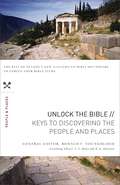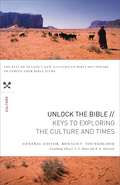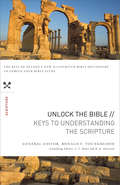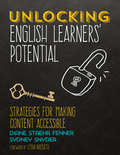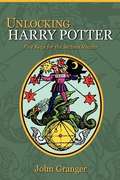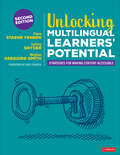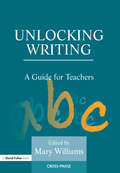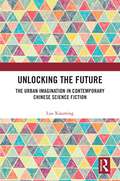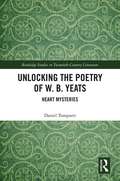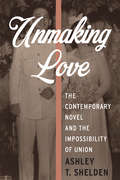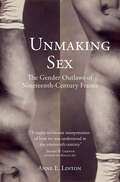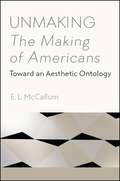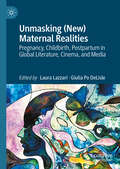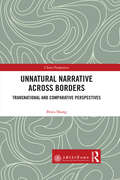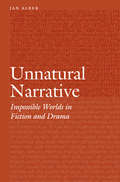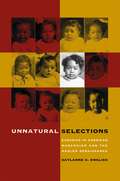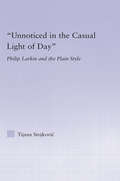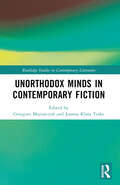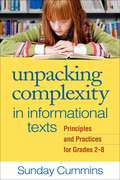- Table View
- List View
Unlock the Bible: Keys to Discovering the People & Places
by F. F. Bruce Ronald Youngblood R. K. HarrisonBuild your Bible study library with this essential book on the people and places of the Bible. Unlock the Bible: Keys to Discovering the People & Places includes the best articles on the most important people and places in Scripture. Each article is drawn from Nelson's New Illustrated Bible Dictionary. Under the direction of Ronald F. Youngblood, the world's leading evangelical scholars updated and revised classic articles drawn from Herbert Lockyer, F. F. Bruce, and R. K. Harrison's extensive Bible dictionary. Features include: Alphabetical listing of topics Works with any major translation Pronunciation guide
Unlock the Bible: Keys to Exploring the Culture & Times
by Ronald F. YoungbloodBuild your Bible study library with this essential book on the cultures and history of the biblical world. Each article comes from Nelson's New Illustrated Bible Dictionary. This volume of the Unlock the Bible series includes articles on the most important kingdoms, peoples, and events in Scripture. Under the direction of Ronald F. Youngblood, the world's leading evangelical scholars updated and revised classic articles drawn from Herbert Lockyer, F. F. Bruce, and R. K. Harrison's extensive Bible dictionary. Features include: The most useful information at your fingertips Single-column format Maps and charts
Unlock the Bible: Keys to Understanding the Scripture
by Ronald F. YoungbloodEnrich your Bible study with one convenient book. Unlock the Bible: Keys to Understanding the Scripture includes the best articles on reading the books of the Bible, drawn from Nelson's New Illustrated Bible Dictionary. Under the direction of Ronald F. Youngblood, the world's leading evangelical scholars updated and revised classic articles drawn from Herbert Lockyer, F. F. Bruce, and R. K. Harrison's extensive Bible dictionary. Outlines, maps, pictures, and charts make the Bible's contents clearer for pastors, teachers, students, and devotional readers. Features include: The most useful information at your fingertips Works with any major translation Outlines, maps, and charts
Unlocking English Learners' Potential: Strategies for Making Content Accessible
by Diane Staehr Fenner Sydney C. Snyder“Schools are not intentionally equitable places for English learners to achieve, but they could be if the right system of support were put in place. Diane Staehr Fenner and Sydney Snyder recommend just such a system. Not only does it have significant potential for providing fuller access to the core curriculum, it also provides a path for teachers to travel as they navigate the individual needs of students and support their learning journeys.” —Douglas Fisher, Coauthor of Visible Learning for Literacy A once-in-a-generation text for assisting a new generation of students Content teachers and ESOL teachers, take special note: if you’re looking for a single resource to help your English learners meet the same challenging content standards as their English-proficient peers, your search is complete. Just dip into this toolbox of strategies, examples, templates, and activities from EL authorities Diane Staehr Fenner and Sydney Snyder. The best part? Unlocking English Learners’ Potential supports teachers across all levels of experience. The question is not if English learners can succeed in today’s more rigorous classrooms, but how. Unlocking English Learners’ Potential is all about the how: How to scaffold ELs’ instruction across content and grade levels How to promote ELs’ oral language development and academic language How to help ELs analyze text through close reading and text-dependent questions How to build ELs’ background knowledge How to design and use formative assessment with ELs Along the way, you’ll build the collaboration, advocacy, and leadership skills that we all need if we’re to fully support our English learners. After all, any one of us with at least one student acquiring English is now a teacher of ELs.
Unlocking English Learners' Potential: Strategies for Making Content Accessible
by Diane Staehr Fenner Sydney C. Snyder“Schools are not intentionally equitable places for English learners to achieve, but they could be if the right system of support were put in place. Diane Staehr Fenner and Sydney Snyder recommend just such a system. Not only does it have significant potential for providing fuller access to the core curriculum, it also provides a path for teachers to travel as they navigate the individual needs of students and support their learning journeys.” —Douglas Fisher, Coauthor of Visible Learning for Literacy A once-in-a-generation text for assisting a new generation of students Content teachers and ESOL teachers, take special note: if you’re looking for a single resource to help your English learners meet the same challenging content standards as their English-proficient peers, your search is complete. Just dip into this toolbox of strategies, examples, templates, and activities from EL authorities Diane Staehr Fenner and Sydney Snyder. The best part? Unlocking English Learners’ Potential supports teachers across all levels of experience. The question is not if English learners can succeed in today’s more rigorous classrooms, but how. Unlocking English Learners’ Potential is all about the how: How to scaffold ELs’ instruction across content and grade levels How to promote ELs’ oral language development and academic language How to help ELs analyze text through close reading and text-dependent questions How to build ELs’ background knowledge How to design and use formative assessment with ELs Along the way, you’ll build the collaboration, advocacy, and leadership skills that we all need if we’re to fully support our English learners. After all, any one of us with at least one student acquiring English is now a teacher of ELs.
Unlocking Harry Potter: Five Keys for the Serious Reader
by John GrangerIvory Tower culture mavens have, in patronizing fashion, dismissed the Potter books. Many Christian believers have condemned the books as "gateways to the occult." Is Harry Potter "really just slop" as Yale's Harold Bloom tells us? Are children reading these books in greater danger of joining dangerous cults than those who do not? Reading the books in context and in depth reveals answers to these questions as well as the reason these books upset both the intelligentsia and the true believers (who, it should be noted, are odd bedfellows!).
Unlocking Multilingual Learners’ Potential: Strategies for Making Content Accessible
by Diane Staehr Fenner Sydney Cail Snyder Meghan Gregoire-SmithBring classroom content to life for multilingual learners In this eagerly anticipated revision of their bestselling book, authors Diane Staehr Fenner, Sydney Snyder, and Meghan Gregoire-Smith share dynamic, research-backed strategies that every educator of multilingual learners (MLs) can add to their repertoire. Including more of what educators loved from the first edition—authentic classroom examples, a wide variety of research-based instructional strategies, and practical tools to implement across grade levels and content areas—this is the ultimate practical guide to unlocking the potential of MLs in K-12 classrooms. With fresh graphics and eye-catching colors, this thoroughly revised edition also includes: Considerations for newcomers and students with interrupted or no formal education (SLIFE) An added chapter on building scaffolded instruction and peer learning opportunities into MLs’ academic reading and writing activities Additional opportunities for reflection and application A new unit planning template aligned with research-based instructional practices, including a completed example unit Situated within five core beliefs that frame the must-haves for MLs’ equitable and excellent education, Unlocking Multilingual Learners′ Potential is a guide to research-based practices and a toolbox of strategies every educator can implement to make content accessible and increase language proficiency among MLs.
Unlocking Multilingual Learners’ Potential: Strategies for Making Content Accessible
by Diane Staehr Fenner Sydney Cail Snyder Meghan Gregoire-SmithBring classroom content to life for multilingual learners In this eagerly anticipated revision of their bestselling book, authors Diane Staehr Fenner, Sydney Snyder, and Meghan Gregoire-Smith share dynamic, research-backed strategies that every educator of multilingual learners (MLs) can add to their repertoire. Including more of what educators loved from the first edition—authentic classroom examples, a wide variety of research-based instructional strategies, and practical tools to implement across grade levels and content areas—this is the ultimate practical guide to unlocking the potential of MLs in K-12 classrooms. With fresh graphics and eye-catching colors, this thoroughly revised edition also includes: Considerations for newcomers and students with interrupted or no formal education (SLIFE) An added chapter on building scaffolded instruction and peer learning opportunities into MLs’ academic reading and writing activities Additional opportunities for reflection and application A new unit planning template aligned with research-based instructional practices, including a completed example unit Situated within five core beliefs that frame the must-haves for MLs’ equitable and excellent education, Unlocking Multilingual Learners′ Potential is a guide to research-based practices and a toolbox of strategies every educator can implement to make content accessible and increase language proficiency among MLs.
Unlocking Secrets: My Journey To An Open Heart
by Kathe CrawfordIn this inspiring, soul-searching, and deeply vulnerable memoir, Kathe Crawford lays bare the life of secrets that she kept for many years. When Crawford and her husband, Larry, discovered that Larry was HIV-positive in 1988, they decided to keep the diagnosis a secret from everyone, including their two children. Crawford kept this promise, layering secret upon secret, for almost 30 years, including for more than 20 years after Larry’s death and even as time revealed painful betrayals. Crawford’s journey of unlocking her own secrets, as well as her family’s, was the key to freeing her voice, opening her heart, and finding her true self.
Unlocking Writing: A Guide for Teachers (Unlocking Series)
by Mary WilliamsThe underpinning theme of this book is how children develop as writers and how self-awareness raises achievement. It offers creative approaches to increasing pupil motivation and performance by involving, amongst other things, Drama and ICT. The contributors offer practical advice on ways to meet the needs of boys, able children, SEN pupils and those learning English as an additional language; how to plan effective lessons; how to be flexible within the framework of the NLS; and the role of assessment and how it contributes to self-understanding. Central to all classroom practitioners and students, this innovative book improves general understanding of the process related to composition and transcription and helps to raise the standards of writing in all classrooms.
Unlocking the Future: The Urban Imagination in Contemporary Chinese Science Fiction
by Luo XiaomingThe book highlights the urban imagination in contemporary Chinese science fiction, in order to assess the capacity of Chinese society to conceive of the future. The author argues that ‘the future’ is a set of directional and normative ideas that forms the basis of the entire social mobilization mechanism in China, while the capacity to imagine the future is likely to be produced in response to the present challenges. By discussing the urban space, the reconstruction of time, the infrastructure, and concepts of the 'urban-rural' and civilization in contemporary Chinese science fiction, she demonstrates how contemporary Chinese sci-fi may offer potential solutions to ways of ‘unlocking’ the future. In addition, she also points out the limitations of Chinese society’s imaginative vision of the future. The book will be of interest to scholars and postgraduate students of modern Chinese literature, science fiction studies, urban studies, or cultural studies.
Unlocking the Poetry of W. B. Yeats: Heart Mysteries (Routledge Studies in Twentieth-Century Literature)
by Daniel TompsettUnlocking the Poetry of W.B. Yeats undertakes a thorough re-reading of Yeats' oeuvre as an extended meditation on the image and theme of the heart as it is evident within the poetry. It places the heart at the centre of a complex web of Yeatsian preoccupations and associations—from the biographical, to the poetic and philosophical, to the mythological and mystical. In particular, the book seeks to unlock Yeats’ mystifying aesthetic vision via his understanding of the ancient Egyptian "Weighing of the Heart" ceremony. The work provides a chronological narrative arc that looks to use the theme of the heart as it recurs in the poetry in order to circumvent and overcome more established frameworks. Its purpose is to offer refreshing ways of conceptualizing and building alternatives to more deeply entrenched, but not entirely satisfactory arguments that have been offered since Yeats' death in 1939, while demonstrating the centrality of the occult to Yeats' art.
Unmaking Love: The Contemporary Novel and the Impossibility of Union
by Ashley T SheldenThe contemporary novel does more than revise our conception of love-it explodes it, queers it, and makes it unrecognizable. Rather than providing union, connection, and completion, love in contemporary fiction destroys the possibility of unity, harbors negativity, and foregrounds difference. Unmaking Love explores the novelistic strategies that Ian McEwan, Zadie Smith, Hanif Kureshi, Alan Hollinghurst, and Hari Kunzru have used to fracture the ideal of romantic fusion. Working within the emergent field of love studies, Unmaking Love draws on cutting-edge theories in psychoanalysis and gender and sexuality studies to read love’s role in contemporary literature and its relation to queer negativity. It also compares modern-day and modernist depictions of love to delineate critical continuities and innovations.
Unmaking Love: The Contemporary Novel and the Impossibility of Union (Literature Now)
by Ashley SheldenThe contemporary novel does more than revise our conception of love—it explodes it, queers it, and makes it unrecognizable. Rather than providing union, connection, and completion, love in contemporary fiction destroys the possibility of unity, harbors negativity, and foregrounds difference. Comparing contemporary and modernist depictions of love to delineate critical continuities and innovations, Unmaking Love locates queerness in the novelistic strategies of Ian McEwan, Zadie Smith, Hanif Kureshi, Alan Hollinghurst, and Hari Kunzru. In their work, "queer love" becomes more than shorthand for sexual identity. It comes to embody thwarted expectations, disarticulated organization, and unnerving multiplicity. In queer love, social forms are deformed, affective bonds do not bind, and social structures threaten to come undone. Unmaking Love draws on psychoanalysis and gender and sexuality studies to read love's role in contemporary literature and its relation to queer negativity.
Unmaking Sex: The Gender Outlaws of Nineteenth-Century France
by Anne E. LintonDuring the nineteenth century, words like 'intersex' and 'trans' had not yet been invented to describe individuals whose bodies, or senses of self, conflicted with binary sex. But that does not mean that such people did not exist. In nineteenth-century France, case studies filled medical journals, high-profile trials captured headlines, and doctors staked their reputations on sex determinations only to have them later reversed by colleagues. While medical experts fought over what separated a man from a woman, novelists began to explore debates about binary sex and describe the experiences of gender-ambiguous characters. Anne Linton discusses over 200 newly-uncovered case studies while offering fresh readings of literature by several famous writers of the period, as well as long-overlooked popular fiction. This landmark contribution to the history of sexuality is the first book to examine intersex in both medicine and literature, sensitively relating historical 'hermaphrodism' to contemporary intersex activism and scholarship.
Unmaking The Making of Americans: Toward an Aesthetic Ontology
by E. L. McCallumArguing that Gertrude Stein's monumental novel The Making of Americans models a radically aesthetic relation to the world, E. L. McCallum demonstrates how the novel teaches us to read differently, unmaking our habits of reading. Each of the chapters works through close readings of Stein's text and a philosophical interlocutor to track a series of theoretical questions: what forms queer time, what are the limits of story, how do we feel emotion, how can we agree on a shared reality if interpretation and imagination intervene, and how do particular media shape how we convey this rich experience? The formally innovative agenda and epistemological drive of Stein's novel stages rich thought experiments that bear on questions that are central to some of the most vibrant conversations in literary studies today. In the midst of ongoing debates about the practices of reading, the difficulty of reading, and even the impossibility of reading, the moment has come to have a fuller critical engagement with this landmark novel. This book shows how.
Unmasking (New) Maternal Realities: Pregnancy, Childbirth, Postpartum in Global Literature, Cinema, and Media
by Laura Lazzari Giulia Po DeLisleThis book aims to shed light on artistic works centered on mothering and reproductive experiences, ones which defy outdated stereotypes, break taboos, overcome trauma, and empower women. The goal of this collection is to contribute to this field of studies and foster our understanding of what motherhood and mothering really look like in our society. Throughout this collaborative volume, the voices of established and emerging scholars merge to broaden the discourse on maternity by examining the complex and constantly evolving maternal experiences that are unique and yet transnational and universal in their essence.
Unnamable: The Ends of Asian American Art
by Susette MinRedraws the contours of Asian American art, attempting to free it from a categorization that stifles more than it reveals. Charting its historical conditions and the expansive contexts of its emergence, Susette Min challenges the notion of Asian American art as a site of reconciliation or as a way for marginalized artists to enter into the canon or mainstream art scene. Pressing critically on the politics of visibility and how this categorization reduces artworks by Asian American artists within narrow parameters of interpretation, Unnamable reconceives Asian American art not as a subset of objects, but as a medium that disrupts representations and embedded knowledge. By approaching Asian American art in this way, Min refigures the way we see Asian American art as an oppositional practice, less in terms of its aspirations to be seen—its greater visibility—and more in terms of how it models a different way of seeing and encountering the world. Uniquely presented, the chapters are organized thematically as mini-exhibitions, and offer readings of select works by contemporary artists including Tehching Hsieh, Byron Kim, Simon Leung, Mary Lum, and Nikki S. Lee. Min displays a curatorial practice and reading method that conceives of these works not as “exemplary” instances of Asian American art, but as engaged in an aesthetic practice that is open-ended. Ultimately, Unnamable insists that in order to reassess Asian American art and its place in art history, we need to let go not only of established viewing practices, but potentially even the category of Asian American art itself.
Unnatural Narrative across Borders: Transnational and Comparative Perspectives (China Perspectives)
by Biwu ShangThis book actively engages with current discussion of narratology, and unnatural narrative theory in particular. Unsatisfied with the hegemony of European and Anglo-American narrative theory, it calls for a transnational and comparative turn in unnatural narrative theory, the purpose of which is to draw readers’ attention to those periphery and marginalized narratives produced in places other than England and America. It places equal weight on theoretical exploration and critical practice. The book, in addition to offering a detailed account of current scholarship of unnatural narratology, examines its core issues and critical debates as well as outlining a set of directions for its future development. To present a counterpart of Western unnatural narrative studies, this book specifically takes a close look at the experimental narratives in China and Iraq either synchronically or diachronically. In doing so, it aims, on the one hand, to show how the unnatural narratives are written and to be explained differently from those Western unnatural narrative works, and on the other hand, to use the particular cases to challenge the existing narratological framework so as to further enrich and supplement it. The book will be useful and inspiring to those scholars working in such broad fields as narrative theory, literary criticism, cultural studies, semiotics, media studies, and comparative literature and world literature studies.
Unnatural Narrative: Impossible Worlds in Fiction and Drama (Frontiers of Narrative #9)
by Jan AlberA talking body part, a character that is simultaneously alive and dead, a shape-changing setting, or time travel: although impossible in the real world, such narrative elements do appear in the storyworlds of novels, short stories, and plays. Impossibilities of narrator, character, time, and space are not only common in today’s world of postmodernist literature but can also be found throughout the history of literature. Examples include the beast fable, the heroic epic, the romance, the eighteenth-century circulation novel, the Gothic novel, the ghost play, the fantasy narrative, and the science-fiction novel, among others.Unnatural Narrative looks at the startling and persistent presence of the impossible or “the unnatural” throughout British and American literary history. Layering the lenses of cognitive narratology, frame theory, and possible-worlds theory, Unnatural Narrative offers a rigorous and engaging new characterization of the unnatural and what it yields for individual readers as well as literary culture. Jan Alber demonstrates compelling interpretations of the unnatural in literature and shows the ways in which such unnatural phenomena become conventional in readers’ minds, altogether expanding our sense of the imaginable and informing new structures and genres of narrative engagement.
Unnatural Selections
by Daylanne K. EnglishChallenging conventional constructions of the Harlem Renaissance and American modernism, Daylanne English links writers from both movements to debates about eugenics in the Progressive Era. She argues that, in the 1920s, the form and content of writings by figures as disparate as W. E. B. Du Bois, T. S. Eliot, Gertrude Stein, and Nella Larsen were shaped by anxieties regarding immigration, migration, and intraracial breeding. English's interdisciplinary approach brings together the work of those canonical writers with relatively neglected literary, social scientific, and visual texts. She examines antilynching plays by Angelina Weld Grimke as well as the provocative writings of white female eugenics field workers. English also analyzes the Crisis magazine as a family album filtering uplift through eugenics by means of photographic documentation of an ever-improving black race.English suggests that current scholarship often misreads early-twentieth-century visual, literary, and political culture by applying contemporary social and moral standards to the past. Du Bois, she argues, was actually more of a eugenicist than Eliot. Through such reconfiguration of the modern period, English creates an allegory for the American present: because eugenics was, in its time, widely accepted as a reasonable, progressive ideology, we need to consider the long-term implications of contemporary genetic engineering, fertility enhancement and control, and legislation promoting or discouraging family growth.
Unnoticed in the Casual Light of Day: Phillip Larkin and the Plain Style (Studies in Major Literary Authors)
by Tijana StojkovicLarkin's poems are often regarded as falling somewhere between the traditional 'plain' and the more contemporary 'postmodern' categories. This study undertakes a comprehensive linguistic and historical study of the plain style tradition in poetry, its relationship with so-called 'difficult' poetry, and its particular realization in the cultural and historical context of 20th-century Britain. The author examines the nature of poetry as a type of discourse, the elements of, and factors in, the development of literary styles, a close rhetorical examination of Larkin's poems within the described poetic frameworks, and his position in the British twentieth-century poetic canon.
Unorthodox Minds in Contemporary Fiction (Routledge Studies in Contemporary Literature)
by Grzegorz Maziarczyk Joanna Klara TeskeUnorthodox Minds in Contemporary Fiction seeks to provide an overview of the ways in which broadly understood contemporary fiction envisions, explores and engenders minds going beyond the classical models. The opening essay discusses the complex relationships between such innovative concepts of the mind and experimental techniques for presenting mentality. The chapters which follow focus on (dis)embodied and/or extended mind, virtuality of avatar minds, intermental thought of reader communities, the capability of artificial intelligence (and humans) for genuine selfless love, the interplay between technology and affect in posthuman consciousness. The books under discussion include Murmur by Will Eaves, The Unfortunates by B.S. Johnson, The Satanic Verses by Salman Rushdie, H(A)PPY by Nicola Barker and Machines Like Me by Ian McEwan. A piece of conceptual fiction by Steve Tomasula, one of the most innovative American novelists of our times, exploring the human mind’s alleged power to transcend its biological limits, complements these scholarly inquiries.
Unpacking Complexity in Informational Texts
by Sunday CumminsTo acquire content knowledge through reading, students must understand the complex components and diverse purposes of informational texts, as emphasized in the Common Core State Standards (CCSS). This practical book illuminates the ways in which a text's purpose, structure, details, connective language, and construction of themes combine to create meaning. Classroom-tested instructional recommendations and "kid-friendly" explanations guide teachers in helping students to identify and understand the role of these elements in different types of informational texts. Numerous student work samples, excerpts from exemplary books and articles, and a Study Guide with discussion questions and activities for professional learning add to the book's utility.
